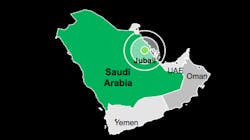Invensys Services Team Delivers Integrated Refinery Information System
The refinery joint venture known as SATORP, which stands for Saudi Aramco Total Refining and Petrochemical Company, is building a greenfield export refinery and petrochemical facility in Jubail Industrial Zone 2 in the Kingdom of Saudi Arabia. Plans are to create the second largest refinery in KSA with a refining capacity of 400,000 barrels per day of “white” petroleum products, including gasoline, diesel, jet fuel, Naphtha and LPG.
SATORP executives knew they needed an integrated, real-time performance monitoring and management system to support the operation. Invensys won the multi-million-dollar contract, taking end-to-end responsibility for the technology, its integration and support for SATORP’s ongoing business processes development to sustain optimal production. The goal was to help SATORP become agile, competitive and profitable from the first day of operation.
SATORP IRIS is an integrated manufacturing operations management system in the refinery that is driven by a set of well-defined business processes using tools, process and technology to deliver a "best in class" solution based on industry standard and best practice. “This project was about bringing multiple technologies together and defining business processes with the customer,” said Omar Halaseh, Invensys Global Pursuits leader. It involved integrating 50 business processes with 80 integration touch points, including 27 ESB interfaces, 12 applications integrated across all 4 ISA-95 layers and business monitoring capabilities and workflows.
Stan DeVries is Invensys' senior director of solutions architecture and the SATORP design lead. He said that, culturally and philosophically, the project involved “combining the well-defined and regimented business processes of the Saudi ARAMCO-influenced front end of the business with the agility, diversity and speed needed to serve world markets on the back end, coming from the Total S.A. portion of the joint venture.”
Architecturally, “what we were asked to do was both vertical and horizontal integration of MOM systems (level 3) from PCS layer (levels 1&2) to EBS layer (level 4) and with some SAP components—what is the current value of the product inventory, logistics of ships and pipelines, specification management, etc.—with ISA-95 level 3 production data,” said DeVries.
Invensys “did not just glue software together. We provided infrastructure services,” added DeVries. They based their architecture on Microsoft BizTalk, SharePoint and more, and integrated production applications with SAP business applications to obtain needed data without recreating it.
“It’s not just data integration, it’s visualization integration and business process integration. We analyzed all business processes and we supplied an integration architecture design enables information sharing across multiple applications for data integrity and consistency without data duplication that has links to all that data. We don’t create copies of data, we create a data store that includes reference information,” explained DeVries.
The project is now 98 percent complete. Some portions started up in July and others are “going online as we speak,” said Halaseh in a presentation at the Invensys Software Conference. To ensure smooth startup, “users would use portions of the system we delivered months before the plant refinery is fully operational,” he said. “They are being trained on the actual systems, and some of the applications are already in use in some of the refinery process units including utilities and CDU units. so by the time the refinery is ready, the people are ready as well.”
DeVries said that Invensys' team participation and involvement from the beginning was crucial to the project’s success. The SATORP project also delivered other important insights about what’s needed to successfully execute such a large project. This includes:
•Clear business process requirements approved by all parties.
•Strong execution governance with a well-defined and proven project methodology.
• Skilled human resources on the project, with well-planned resource loading and unloading during the course of execution.
• A standardized naming convention for assets where possible, with well-defined data reference models for mapping between applications.
• A very strong change management process to manage “scope creeps” and any functional & design changes.
• Well-defined testing strategy based on industry standard and best practices.
•Organizational change management services.

